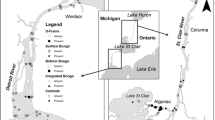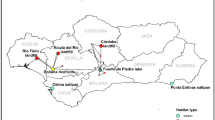Abstract
Black Redhorse (Moxostoma duquesnei) larval and juvenile habitat was characterized in the Grand River, Ontario from June to September 2007–2012. Similar to adult Black Redhorse and their congeners, larval Black Redhorse were most likely to be located in clean, clear, stable runs with low to moderate flow, over pebble, gravel and cobble substrate, mixed with sand. Areas (n = 22) where 0+ Black Redhorse were observed and collected were 1.4 ± 0.2 m from shore, with a mean water temperature of 22.0 ± 0.5 °C, mean depth of 0.20 ± 0.02 m and mean water velocity of 0.12 ± 0.05 m/s. Larval and juvenile Black Redhorse occupied riffles, runs, pools and backwater areas; however, there was a strong preference for runs. Juvenile Black Redhorse moved upstream in the early evening and at night to overwintering areas in the Grand River in November when water temperature approached 5 °C. The persistence of Black Redhorse populations in the Grand River may be related to the presence of groundwater, which provides refuge from extreme temperature and poor water quality during the summer.


Similar content being viewed by others
References
Baird OE, Krueger CC (2003) Behavioral thermoregulation of brook and rainbow trout: comparison of summer habitat use in an Adirondack river, New York. T Am Fish Soc 132:1194–1206
Biro PA (1998) Staying cool: behavioural thermoregulation during summer by young-of-year brook trout in a lake. T Am Fish Soc 127:212–222
Bowman ML (1970) Black redhorse life history. T Am Fish Soc 3:546–559
Brown RS (1999) Fall and early winter movements of cutthroat trout, Oncorhynchus clarki, in relation to water temperature and ice conditions in Dutch creek, Alberta. Environ Biol Fish 55:359–368
Bunt CM, Mandrak NE, Heiman TM (2013) Ontogeny of black redhorse (Moxostoma duquesnei). Copeia 1:120–125
Cooke SJ, Bunt CM, Hamilton SJ, Jennings CA, Pearson MP, Cooperman MS, Markle DG (2005) Threats, conservation strategies, and prognosis for suckers (Catostomidae) in North America: insights from regional case studies of a diverse family of non-game fishes. Biol Conserv 121:317–331
COSEWIC (2004) COSEWIC assessment and update status report on the copper redhorse Moxostoma hubbsi in Canada. Committee on the Status of Endangered Wildlife in Canada. Ottawa.vii + 38 pp. (www.sararegistry.gc.ca/status/status_e.cfm)
COSEWIC (2005) COSEWIC assessment and update status report on the black redhorse Moxostoma duquesnei in Canada. Committee on the Status of Endangered Wildlife in Canada. Ottawa. vi + 21 pp. (www.sararegistry.gc.ca/status/status_e.cfm)
COSEWIC (2006) COSEWIC assessment and update status report on the river redhorse Moxostoma carinatum in Canada. Committee on the Status of Endangered Wildlife in Canada. Ottawa. vi + 31 pp. (www.sararegistry.gc.ca/status/status_e.cfm)
Cummins KW (1962) An evaluation of some techniques for the collection and analysis of benthic samples with special emphasis on lotic waters. Am Nat 67:477–504
Ebersole JL, Liss WJ, Frissell CA (2001) Relationship between stream temperature, thermal refugia and rainbow trout Oncorhynchus mykiss abundance in arid-land streams in the northwestern United States. Ecol Freshw Fish 10(1):1–10
Hayashi M, Rosenberry DO (2002) Effects of groundwater exchange on the hydrology and ecology of surface water. Ground Water 40(3):309–316
Kay LK, Wallus R, Yeager BL (1994) Reproductive biology and early life history of fishes in the Ohio River Drainage, volume 2: Catostomidae. Tennessee Valley Authority, Chattanooga
Kwak TJ, Skelly TM (1992) Spawning habitat, behavior and morphology as isolating mechanisms of the golden redhorse, Moxostoma erythrurum, and the black redhorse, M. duquesnei, two syntopic fishes. Environ Biol Fish 34:127–137
Labbe TR, Fausch KD (2000) Dynamics of intermittent stream habitat regulate persistence of a threatened fish at multiple scales. Ecol Appl 10(6):1774–1971
Neal C, Hill T, Alexander S, Reynolds B, Hill S, Dixon AJ, Harrow M, Neal M, Smith CJ (1997a) Stream water quality in acid sensitive UK upland area; an example of potential water quality remediation based on groundwater manipulation. Hydrol Earth Syst Sc 1:185–196
Neal C, Robson AJ, Shand P, Edmunds WM, Dixon AJ, Buckley DK, Hill S, Harrow M, Neal M, Wilkinson J, Reynolds B (1997b) The occurrence of groundwater in the lower Paleozoic rocks of upland central Wales. Hydrol Earth Syst Sc 1(1):3–18
Neal C, Jarvie HP, Howarth SM, Whitehead PG, Williams RJ, Neal M, Harrow M, Wickham H (2000) The water quality of the River Kennet: initial observations on a lowland chalk stream impacted by sewage inputs and phosphorus remediation. Sci Total Environ 251–252:477–495
Ostry RC (2007) Relationship of water quality and pollutant loads to land uses in adjoining watersheds. J Am Water Resour As 18(1):99–104
Reash RJ, Seegert GL, Goodfellow WL (2000) Experimentally-derived upper thermal tolerances for redhorse suckers: revised 316(A) variance conditions at two generating facilities in Ohio. Envir Sci R 3(1):191–196
Reid SM (2006) Relationship between habitat quality and occurrence of the threatened black redhorse (Moxostoma duquesnei) in Lake Erie tributaries. Water Qual Res J Can 41(4):341–350
Reid SM (2009) Age, growth and mortality of black redhorse (Moxostoma duquesnei) and shorthead redhorse (M. macrolepidotum) in the Grand River, Ontario. J Appl Ichthyol 25(2):178–183
Reid SM, Wilson CC, Mandrak NE, Carl LM (2008) Population structure and genetic diversity of black redhorse (Moxostoma duquesnei) in a highly fragmented watershed. Conserv Genet 9(3):531–546
Snucins EJ, Gunn JM (1995) Coping with a warm environment: behavioural thermoregulation by lake trout. T Am Fish Soc 124(1):118–123
Vélez-Espino LA, Koops MA (2009) Quantifying allowable harm in species at risk: application to the laurentian black redhorse (Moxostoma duquesnei). Aquat Conserv 19(6):678–688
Zar JH (1984) Biostatistical analysis. Prentice-Hall Inc, New Jersey
Acknowledgments
We would like to thank Mark Anderson from the Grand River Conservation Authority for providing water quality data. Heinrich Bier and Bill Sack assisted with field sampling and data collection. Partial funding for the preparation of this document was provided by Fisheries and Oceans Canada, and in-kind by Biotactic Incorporated. All appropriate animal care and research ethics committee protocols were adhered to for this project.
Author information
Authors and Affiliations
Corresponding author
Rights and permissions
About this article
Cite this article
Bunt, C.M., Mandrak, N.E., Eddy, D.C. et al. Habitat utilization, movement and use of groundwater seepages by larval and juvenile Black Redhorse, Moxostoma duquesnei . Environ Biol Fish 96, 1281–1287 (2013). https://doi.org/10.1007/s10641-013-0113-y
Received:
Accepted:
Published:
Issue Date:
DOI: https://doi.org/10.1007/s10641-013-0113-y




